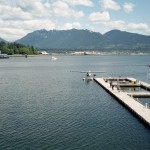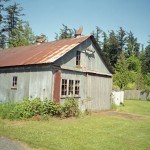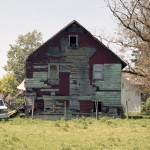Jun
30
2012

I’m always on the lookout for obscure photography items I can use or put on display so I hit the jackpot here. I picked this stuff up from an antique shop for about the cost of one of the batteries at a store. I’ve already put a hard to find battery into my Canon 110ED camera and will also put that roll of 110 in the picture into it too. The old vials of developer are going to go on display along with the empty box of Kodak sheet film.
2 comments | tags: batteries, Cameras, film | posted in Cameras, Photography
Jun
27
2012
As Polaroid SX70 film hasn’t been manufacured for some time and the chemicals tend to dry up as the film ages, the ability to directly move the emulsion around like you once could with SX70 film is done. I have to admit I didn’t do a lot of it when I could have back in the 1990’s but even then Polaroid film was quite expensive. I found this one that I had done among a bunch of other prints. I like it but I think some of my favourites have been lost over the years.

It could be fun to try to recreate the look digitally, I’ll have to give that some thought.
1 comment | tags: film, polaroid | posted in Photography
Jun
24
2012

Heavy on the style and epicness. This was a camera that sold very well for Olympus, in the millions, so there are many out there to be enjoyed and they really should be. At it’s core it is a 35mm 4 element f2.8 lens that is very sharp without a lot of distortion, but with a bit of vignetting. It is a point and shoot and therefore doesn’t offer many overrides, primarily control of the flash but it focuses well and the exposure is almost always spot on. It is a very small camera which easily slips into a pocket. The fact that it turns on by simply opening the clam shell makes it easy to prepair for use without needing to look at the camera to locate the on button as is the case with many other cameras. The Stylus Epic out performs it’s current cost ten times over and deserves it’s cult status.
More samples shots from the Olympus Stylus Epic
5 comments | tags: Cameras, film, olympus | posted in Cameras, Photography
Jun
21
2012

The Konica Lexio 70 was introduced in 2000 and thankfully wasn’t the hope for the new millennium because despite having good specifications on paper it’s let down by a lens that creates images unsafe for viewing. Perhaps not quite that bad but I would include this camera in the Lo-Fi category along with plastic lens cameras just because of the distortion and ugly bokeh
A weird thing about the Konica Lexio 70 is that when it focuses the viewfinder framing changes with the lens focus movement, I can’t tell if the image is captured with the new framing after this change of view. Also a design fault with this camera is the lens cover on/off switch. It performs it’s on off function at the most inopportune time with the slightest movement of the lens cover.
You can see in the following image that the bokeh is horrible, as this is the only Lexio 70 I have to test I don’t want to make any presumptions but I will, I doubt it gets much better. It also has some weird pincushion distortion at the wide end that isn’t even across the frame. I found another persons set on Flickr had the same distortion so I believe it’s a characteristic of the camera. This appears most obviously with straight lines that become stretched upwards towards the edges. This may be caused by the aspherical elements in the lens and is much more dramatic than with a simpler lens design.

What I do like about it is that although it resets to full auto after powering off and on it does remember the last setting you had selected so that when you press the mode button it jumps to that one, which can be any of the eight over rides it provides.

As it affords a 28mm focal length at the wide end, which is somewhat rare in a point and shoot, it’s worth picking one out of the thrift store pile for a couple dollars. That is as long as you know the limitations.
1 comment | tags: camera, film, Konica | posted in Cameras, Photography, Uncategorized
Jun
19
2012


I was graciously given the Yashica Samurai by a friend who recognized that it would interest me, and it does. It’s a half frame camera producing 50 negatives from a standard 24 exposure roll of film. That itself is interesting, it makes you feel less encumbered by the preciousness of the film. It feels almost like shooting digitally you have so many exposures available. Then there is the form of the camera, which is somewhere between an old video camera and a…..I got nothing it’s between an old video camera and nothing. It is an actually SLR with a mirror and a direct view through the lens but rather than the film travelling horizontally the film travels vertically like it would in a movie camera. This provides the opportunity to create vertical stitches of images on the film which I will cover in a later post. The lens is a 25 to 75mm zoom which because of the half frame nature of the camera translates into a 35mm equivalent of 35 to 105mm. Despite being an SLR the camera doesn’t allow manual control or overide of the exposure so it’ functions more like any other point and shoot film camera that looks like a video camera from 1993.
2 comments | tags: film, Yashica | posted in Cameras, Photography, Uncategorized
Jun
16
2012
When you capture images on film they are connected to neighbouring ones by their position on the substrate, where a digital file is on it’s own, easily orphaned or separated. That’s all a bit overly dramatic what I should say is that it’s fun to take images on film that are meant to exist together and this is harder to do on film than bringing them together after the fact as you would with two digital pictures. As this is the first time I have used the half frame Yashica Samurai it didn’t always work out but you learn from doing. My first error was miscalculating the field of view of the viewfinder. I framed the images that were supposed to go one on top of the other as if the viewfinder provided a 100% view, it does not. So the result is that rather than being a seamless image formed from two frames I have two images with overlapping content separated by a black band, that is a failure. The other mistake I made was when I turned the camera on it’s side and tried to do a multi-image panoramic. I panned in the wrong direction but I will get to that in a minute.
 What I’ve done here is scan the two half frame exposures as one image.
What I’ve done here is scan the two half frame exposures as one image.
And what follows are my attempts at creating a single image from two frames.



Now the panorama should look something like this, but with black bands between the frames, (This is from the same scanned images joined with software.) but it ended up looking like this on the negative.
but it ended up looking like this on the negative.
The reason for this is that I panned from left to right which is the opposite direction of what I should have done, illustrated on a napkin like this  If I want the sun to be above the tree and not under the ground I need to first capture the tree image and then pan up to capture the sun when the film moves in the direction of the arrow. When you turn the camera on it’s side this translates into starting on the right and panning left, oops. The good thing is there is lots of room for improvement and experimentation, particularly interesting to me is the prospect of the image pairs.
If I want the sun to be above the tree and not under the ground I need to first capture the tree image and then pan up to capture the sun when the film moves in the direction of the arrow. When you turn the camera on it’s side this translates into starting on the right and panning left, oops. The good thing is there is lots of room for improvement and experimentation, particularly interesting to me is the prospect of the image pairs.
3 comments | tags: film, photoraphy, Yashica | posted in Photography
Jun
13
2012

This completes another set of 10 original Polaroid Spectra integral films, so I’ve pulled more from the fridge leaving me with 30 exposures.

Remember for best results: Take pictures. Great advice!
1 comment | tags: film, polaroid | posted in Photography, Processing
Jun
11
2012

Briefly the Pentax Z1p was produced from 1994 to 2000 and has many of the features that you find on a DSLR today for controlling exposure and drive modes. Although cryptically hidden by the LCD based system, you can do 2 to 9 multiple exposures as well as bracketing and interval shooting among others.

I like it mostly because I can use my full frame Pentax lenses on both it and my crop sensor DSLR the K-7. The DFA 100 macro WR is particularly well suited to use with it as well as the FA 50 f1.4.
4 comments | tags: film, Pentax | posted in Photography
Jun
9
2012
I’ve been playing around with editing some digital files on the iPad even before I have uploaded them to my computer. One of the things this allows is the freedom to go over the top with the processing, just as most of the images on social sharing services have digital filters applied, editing on the iPad seems like a license to do it there as well. Would I want all my images to be square and highly saturated? No, but there is a certain appeal to it.
no comments | tags: Digital, iPad, Photography | posted in Photography, Processing, Uncategorized
Jun
6
2012
Just some images from my Voigtlander Bessa 46 the“Baby Bessa”. Using these old cameras does make you think about what you are doing. There is no point and shoot nature about it.
As an aside I just had a look on Camera-pedia and saw that the image that is being used for the Bessa 46 is my actual camera. Someone lifted the image from my website and used it, I know this for certain as the metadata of the picture still has the copyright info my Pentax K-7 embeds in each image, besides the fact that well I just knew I had taken it. I wish I could remember peoples names as well as I can remember images I shot.
To keep the circle going here is the image on Camerapedia, I’m linking to it to amuse myself instead of using my own image, well it is mine anyway and the person who used it has since passed away which is a shame because he obviously loved cameras as much as I do.
http://camerapedia.wikia.com/wiki/Voigtl%C3%A4nder_Bessa_66?image=Voigtlander_Bessa_46-jpg
1 comment | tags: Bessa, camera, film | posted in Cameras, Photography









































































